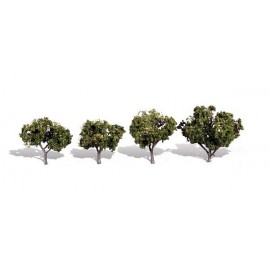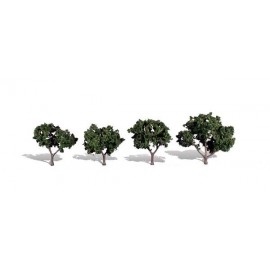You'll likely have come across the term "NEM pockets" when delving into the world of model railway couplers. But what...
No products
Product successfully added to your shopping cart
There are 0 items in your cart. There is 1 item in your cart.
Search Tips
What colour is the foliage of trees in the UK?
When modelling trees for a British railway layout, the foliage colour plays a significant role in bringing realism and atmosphere to the scene. In the UK, trees vary widely in leaf colour depending on the species, the time of year and the environment in which they grow. Capturing these variations can make a layout come to life, offering a sense of place and seasonality.
In spring and summer, trees in the UK are generally lush and green, with different species exhibiting distinct shades. Oak, ash and sycamore trees might have a deep, rich green tone, while birch or willow trees show a lighter, more silvery green. For model railways, incorporating a variety of these greens is important to break up uniformity. Woodland Scenics or other specialist model foliage products offer a range of colours from dark green to lighter hues, allowing you to blend different tones to reflect the natural variation seen in real landscapes.
As you move into autumn, the foliage changes dramatically. Many UK tree species take on hues of orange, yellow, brown and even red, offering a vibrant and varied backdrop for your railway scenes. Adding these autumnal colours to your layout can evoke a particular time of year, which might be perfect if you're modelling a specific season. Products like scenic scatter, ground foam, or even hand-painted trees can be used to replicate this seasonal transformation, giving depth and a sense of realism to your model.
One of the most crucial elements to consider is the texture of the foliage. Real trees, especially from a distance, rarely have leaves that look entirely smooth or uniform. In model railway terms, this is best captured by using a mix of fine and coarse materials. For example, using a combination of fine foliage scatter and coarser foam gives your trees a more three-dimensional, authentic appearance. You can even experiment with layering these materials to achieve a natural, blended look that closely mirrors UK landscapes.
Another key consideration is the type of layout you're creating. Rural settings, typical of many British countryside railway scenes, often feature trees that have varied and mature foliage, with a mixture of deciduous and evergreen species. In contrast, urban areas might feature more manicured or younger trees, with denser and more consistent colours. Understanding the geographical and historical context of your layout can help guide your choice of foliage colours.
Finally, lighting plays a role in how your model trees appear. Natural daylight or artificial layout lighting can cast different shadows and highlight certain colours more strongly. If your layout is permanently indoors, you might want to slightly exaggerate some colours to ensure they don’t appear washed out. Adding subtle touches of colour variation within the foliage, such as hints of yellow or brown even in summer scenes, can add a layer of realism that helps trees blend seamlessly into the overall scene.
By carefully considering the foliage colours, textures, and species on your model railway, you can enhance the realism of your layout, ensuring that the trees look as natural and vibrant as those found in the British countryside.
Click here to receive the tips weekly in your mailbox. You can unsubscribe at any time.










